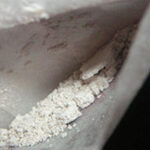Consider the pattern of behavior of a drug addict. The drug most widely recognized as causing complete and utter addiction is probably heroin, so consider a heroin addict. Heroin addiction is characterized by a compulsive, overwhelming need for the drug, which causes the addict to seek the drug out, use it, and do little else. Addicts with severe habits talk of being on “smack time.” Smack is a slang term for heroin and thus smack time refers to being on heroin time, meaning the life of an addict is not governed by hours or minutes or day or night but by how long it’s been since he or she last had a dose of heroin and how long it will be until the next one. For a new user of heroin, not yet an addict, the dosage is a relatively low amount, and is a fraction of what is needed by a heavy user. As the user’s tolerance increases the dosage that the user must take increases, gradually but exponentially, sometimes reaching amounts up to fifty or a hundred times more than was originally used. The method that the drug is administered into the body may also change; snorting may turn to smoking, and smoking to injecting. The life of the user, now an addict, is a series of actions that result in an incrementally escalating intensity, in response to an ever-increasing need and desperation. What was once used as enjoyment becomes a physical need, and as the enjoyment lessens the need greatens.
The example of the heroin user depicted here is meant for the most part to be just that, an example of drug abuse. Dosage, tolerance, frequency of use, and the type of drug being considered are not entirely relevant to the overall point and do not necessarily need to be specified. Addiction to any drug will produce roughly the same pattern. However, there is some significance in why heroin is being considered specifically, significance superior to the fact that it provides an apt example of drug addiction. Heroin, more so than other illicit substances, produces chemicals in the brain that are almost identical to those produced naturally by human emotions, such as when one experiences the feeling of romantic love. This fact suggests a basis for comparison of drug abuse and romantic love on a chemical level.
Heroin is an opiate derived from morphine. It is essentially the same drug as morphine, and produces the same effects, but it is rendered through a chemical process that makes it more soluble in fat. This allows it to enter the brain faster than morphine. Once in the brain, heroin is converted back to morphine and binds to the brain’s mu-opioid receptors. This action blocks pain, an effect called analgesia (from the Greek an-, meaning “without,” and -algia, meaning “pain”), and stimulates the brain into producing the feeling of euphoria that users of heroin seek. Since humans are an adaptive species, the brain eventually develops a tolerance for heroin if it is used repeatedly and incorporates it as a natural part of daily life. After a substantial period of frequent use, heroin users require a much larger dosage of heroin to attain the same level of euphoria thanks to the brain’s adaptive nature.
The similarity of drugs and romantic love is both biochemical and analogical. In the biochemical sense, the feeling that one is in love stimulates the brain to release endorphins. Endorphins (also known as endomorphines or endogenous morphine) are neurotransmitters created naturally in the brain that produce an effect almost identical to heroin/morphine. They bind to most of the same mu-opiod receptors as morphine and produce both analgesia and euphoria. Endorphins also cause a number of other chemicals to be released, one of which is dopamine, which is produced significantly when cocaine or amphetamines are administered to the body. Dopamine affects the body’s natural urges for needs such as that of food and sex, and increased levels of dopamine produce pleasure and a sense of reward. All of this leads to the overall high and sense of well-being experienced upon falling in love. When reduced to biochemical reactions, romantic love is nearly identical to drug abuse.
It should be noted that this similarity is not coincidental, or even surprising. It is, in fact, perfectly coherent with what is known about drugs today. A drug experience and its effects are a product of the actions of neurotransmitters that already exist within the brain. The drug itself does not put these chemicals in the brain, but rather stimulates the brain into producing them on its own. The critical participatory elements that create the sensations of any drug are already there. A drug simply causes them to be released at a time when they would not have been otherwise. This implies that romantic love and other similar emotions are the causes designed by nature to induce such a high, and that drugs are man’s attempt to artificially induce the effects of nature.
Additionally, one may wonder whether romantic love is similar to not just drug abuse, but drug addiction. The chemical similarity between the two provides the basis for a broader comparison. The possibility that romantic love is very similar to drug addiction can be argued in regard to behavior. In the analogical sense, when compared to heroin or any other addictive drug, romantic love produces a very similar pattern of actions. Consider the first and second stages of love as devised by Helen Fisher, a renowned anthropology professor at Rutgers University who is considered the foremost expert on love and interpersonal chemistry. Fisher proposes a total of three stages: lust, attraction, and attachment. Lust, as the word implies, is the instinctual, biological desire to mate and produce offspring. This stage usually lasts only a few weeks, during which testosterone and estrogen are produced in men and women, respectively. Attraction is the more romantic desire for a mate, and it can be considered the height of the love-induced “high.” It is basically lust focused on a specific individual. Increased levels of dopamine are found in people in the attraction stage, resulting in the sense of euphoria and pleasure mentioned earlier. The final stage, attachment, is the stage of commitment. Attachment usually follows marriage and lasts for years or even decades, but is characterized by the brain’s dopamine levels dropping to normal.
The attachment stage can be likened to a heroin or cocaine addict who has previously had a steady, consistent supply of their drug of choice for years and then is suddenly cut off from it. What does the drug addict do? He or she seeks out whichever is their drug of choice and usually obtains it by any means necessary. And what do people in the attachment stage of love, who are staring down the long road of a committed relationship with a single person, do? According to a number of studies and a vast array of different opinions on the resulting data, anywhere from 30% to 60% of married individuals cheat on their spouses. Finding a new partner would effectively take the individual back to the lust or attraction stages of love, reviving the steady supply of dopamine. This could explain why people cheat on their spouses and why the current divorce rate is so high. Perhaps it is simply to satisfy an addiction. Other possible methods of returning to the lust stage are renewing one’s wedding vows or having additional children, though undoubtedly this would produce a much lower level of intensity than infidelity.
Some may say it is tantamount to blasphemy, or at the very least especially crass, to suggest that the concept of romantic love can be reduced to simple chemistry and therefore likened to drug abuse. Beliefs on this matter are probably many and varied, and are, of course, entirely subjective, as is this article. The subject is open to interpretation.


